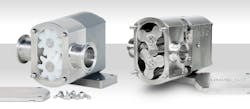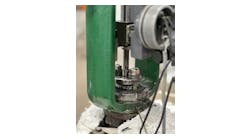Electric motors convert electrical energy to mechanical energy. Many types of electric motors for processing applications exist. A common type is the alternating current (AC) induction motor. The squirrel-cage induction motor remains without question the most common type of electric motor used to drive different mechanical equipment and machinery including pumps, compressors, conveyors and material handling units. The reasons for this are its global availability, excellent reliability, high performance and ease of maintenance. For induction motors, the speed is determined by the number of magnetic poles in the motor and the alternating sinusoidal frequency of the electrical power supplied to the motor.
Many electric motors operate with a magnetic flux linkage of their two magnetic circuits. One of these circuits is in the stator and the other is in the bearing-mounted rotor. This flux linkage produces a moment of force at the rotor radius that results in a torque on the motor shaft causing shaft rotation, which drives the equipment. This article discusses electric motors and drives for different processing applications.
Squirrel-cage induction motors
Three-phase squirrel-cage induction motors are widely used because they are rugged, reliable and economical. Single-phase induction motors are used extensively for smaller machinery and drive trains. Although traditionally used in fixed-speed service, induction motors are increasingly being used with variable frequency drives (VFDs) in variable-speed services. Squirrel-cage induction motors have widely been used in fixed-speed and VFD applications. Such a motor consists of stationary and rotating parts. The rotating rotor is known as a squirrel-cage rotor as it resembles a squirrel cage, whereas the stator is usually completely wound by copper wires with proper insulation. A squirrel-cage rotor usually consists of a cylinder of steel with aluminium or copper conductors embedded in its surface. The motor rotor shape is a cylinder mounted on a shaft. Internally, it contains longitudinal conductive bars (aluminium or copper) set into grooves and connected at both ends by shorting rings forming a cage-like shape.
The solid core of the rotor is built with stacks of electrical steel laminations. The rotor has fewer slots than the stator. The number of slots in the stator should be a non-integer multiple of the number of slots in the rotor to prevent magnetic interlocking of rotor and stator teeth at the start. Commonly used motors for small and medium sizes use die-cast aluminium poured into the rotor after the laminations are stacked. Some larger motors have aluminium or copper bars welded or brazed to end-rings. Since the voltage developed in the squirrel-cage winding is low, no intentional insulation layer is present between the bars and the rotor steel.
Wound-rotor induction motors
The wound-rotor induction motor is similar to the squirrel-cage version in every respect except that the rotor is wound with insulated wire turns and the winding is terminated at a set of slip rings on the rotor shaft. In other words, this motor has a three-phase winding on the rotor, terminated at three slip rings, instead of squirrel-cage construction. The rotor windings have no connection to the power source. The rotor in this case acts like a secondary winding of a transformer. All current in the rotor is derived from the primary current (stator), and is dependent upon the slip of the motor, and the amount of resistance that is in the rotor circuit. In a transformer, the total energy that passes through the transformer will vary according to the demand on the secondary winding. If there is high resistance in the secondary circuit (in this case, the rotor), the current will be reduced.
The reduction of the current reduces the torque that the motor can produce. On the other hand, as the current in the rotor is allowed to increase, the primary current also increases, compounding the available torque, as more magnetic flux is added to both the primary and secondary fields. A wide range of control can be obtained on the motor torque (and amperes) by varying the secondary resistance.
Connections are made to the slip rings through brushes and in turn to an external resistor, which can be adjusted to change the motor speed-torque characteristics. For a wound-rotor induction, increasing the external resistance of the control will cause the peak torque of the motor to be reached at lower speeds until the peak torque occurs at around zero speed. Increasing the resistance beyond this value will cause the motor to have a limited torque. This motor type can be used where torque control is required or where some kind of variable speed operation is needed without using variable speed drives (VSDs). In the variable-speed/variable-torque application, the rotor resistance is adjusted to produce a motor torque that matches the load torque at the specific speed desired. This system is not as useful and cost-effective as a VSD induction motor that relies on newer developments of power electronics and microprocessors. With the availability of VSD squirrel-cage induction motors, these types of variable-load motors are no longer popular or practical. Because the wound-rotor motor is more expensive than the common induction motor, it is no longer a popular choice.
If multiple wound-rotor motors are used to drive synchronized conveyors, the rotors can all be connected in parallel. With a common variable frequency applied to the stators, all motors will lock-step and maintain constant angular rotor relationships, creating what is known as a "synchro" drive. This application can be found in processing plants in which any difference in conveyor speeds would cause problems.
Motor enclosures
Electric motors are manufactured with a variety of mechanical enclosure features to provide protection to the working parts for specific environmental conditions. The electric motor industry has incorporated a number of specific enclosure classifications on standard enclosures for motors. Although these special enclosures are classified and available for different motors, they are not, for different reasons, available for all sizes of motors.
Open enclosures, which permit passage of external cooling air over and around the windings and rotor of the motor, are not suitable for many processing applications so they will not be addressed for the purpose of this article.
Totally enclosed motors do not have any air openings; therefore, there is no free exchange of air between the inside and outside of the motor frame. The construction is not liquid- or airtight. Normally, the rotor has air circulating fins at each end to circulate the trapped inside air and improve convection cooling to the frame. Power ratings of these motors have been limited since they can overheat. Totally enclosed, fan-cooled motors are enclosed motors equipped with an external fan operating on the motor shaft to circulate external air over the outside of the motor. Most motors have cast fins the length of the frame to increase surface area and take advantage of the fan cooling.
An explosion-proof motor is a totally enclosed motor that is designed to withstand an internal explosion of gas or vapor and constructed to prevent ignition by the internal explosion of gases or vapors outside the motor. Totally enclosed, pipe-ventilated enclosures have dedicated ducting or piping to inject and discharge ventilation air from an external source. This creates controlled ventilation.
Totally enclosed, water-cooled enclosed motors are cooled by water passages or conductors inside the motor frame. Another popular enclosed motor design is an enclosed motor equipped with a water-to-air heat exchanger in a closed, recirculating air loop through the motor. Air is circulated through the heat exchanger and motor by integral fans or fans separate from the rotor shaft and powered by a separate set of small motors. This enclosure type is widely used in large, critical, high-power electric motors. Totally enclosed, air-to-air heat exchanger motors are similar to water-to-air heat exchanger motors, except external air is used to remove the heat from the heat exchanger instead of water.
Bearings and lubrication
Many failures and unscheduled shutdowns of electric motors have been related to failure of mechanical parts and components such as bearings and their lubrication. Many small- and medium-sized electric motors have been equipped with rolling-element bearings. For instance, nearly all National Electrical Manufacturers Association (NEMA) frame induction motors are available with rolling-element bearings, mostly ball bearings. The bearings used in a motor should be sealed to keep the lubricant inside the bearing and keep contaminates out. Double-sealed bearings are common for many applications.
Many electric motors manufactured to NEMA standards use grease-lubricated ball bearings with high radial and thrust-load capacities. They are usually axially preloaded to eliminate any radial or axial play for quiet operation and long life. Most motor end frames include an outer-race locking plate on the shaft end bearing to prevent race rotation due to output shaft loads. These bearing mounting features are required for high performance, long life and highly efficient operation. Most electric motor manufacturers provide their larger frame sizes with grease fittings for relubrication during the lifetime of the motor. The smaller frames use bearings that are grease-packed and sealed for life at the factory and cannot be relubricated.
NEMA motors subject to high loads and operating temperatures in larger frames may require oil lubrication to the rolling element bearings. This lubrication can be done by either oil circulation within the bearing frame or from a pressurized lubrication system. In addition, for motors required to carry high thrust loads, quite often in only one direction, taper or spherical roller thrust bearings may be used.
Ball bearings are subject to early failure when used in electric motors driven by some VSD systems. This common problem should be properly addressed. Many reasons exist for such failures, but a common cause is a high carrier frequency used in the VSD inverter to generate the sinusoidal currents for each phase. This results in generation of high common-mode voltages inside the phase windings of the stator.
Because there is an excellent electrostatic coupling between the stator/frame and the rotor from the windings, a voltage is induced in the shaft. The ball bearings represent the least-resistant path for a short circuit to the stator. However, the balls seldom actually contact the races because of the film of grease or oil in between. When the voltage builds up in the shaft until it is greater than the insulating capability of the film of lubricant, the voltages arc across the lubrication gap and a flashover current goes through the bearing. In a short amount of time, the bearing races will become grooved, causing the bearings to become noisy. Metal particulate will then egress from the bearing surfaces as the process continues, causing catastrophic bearing failures after a few months. Therefore, all electric motors that are driven by VSDs, particularly those with pulse-width-modulated (PWM) drives, should have a shaft grounding system to provide a low-resistance path between the shaft and the motor frame. Other solutions exist to this potential problem, which should be discussed with the motor supplier.
A lubrication system is composed of heat exchangers, filters, a reservoir and oil pumps. Large electric motors are generally supplied with oil-lubricated sleeve bearings with oil supplied from a properly designed pressurized lubrication system. In many lubrication systems, common oil-skid-supplied lubrication goes to both the electric motor and driven equipment.
Large motors have bearing heat losses that cannot be dissipated directly; therefore, a pressurized lubrication oil system should be used to supply enough flow of oil for both lubrication and bearing cooling. In such a system, the lubrication oil is pumped into the bearings and allowed to recirculate through a heat exchanger system to transfer the generated heat. The oil delivered to each bearing is metered to provide only the required amount.
Smaller sleeve bearings are in the form of a cylindrical shell and are usually made of steel-backed Babbitt metal. Larger sleeve bearings are usually split on a horizontal centerline, allowing easy assembly and disassembly for inspection and replacement. The bearing housing is also split on the horizontal centerline and held together with bolts between the top and bottom halves.
Conclusion
It is often difficult to note a general rule for electric motor selection. Traditionally, preference has been to use AC induction motors as drivers, particularly squirrel-cage induction motors, because of better reliability and other benefits. However, some power rating ranges and applications like large drivers are better served by other options such as synchronous electric motors. Matters related to mechanical enclosure are critical because they serve as protection of working parts for specific environmental conditions of processing units. Issues related to bearings and lubrication are important for reliability and long-life of all electric motors.
Amin Almasi is a senior rotating machinery consultant in Australia. He is a chartered professional engineer of Engineers Australia and IMechE and holds bachelor’s and master’s degrees in mechanical engineering and RPEQ. He is an active member of Engineers Australia, IMechE, ASME and SPE and has authored more than 100 papers and articles dealing with rotating equipment, condition monitoring, offshore, subsea and reliability.



